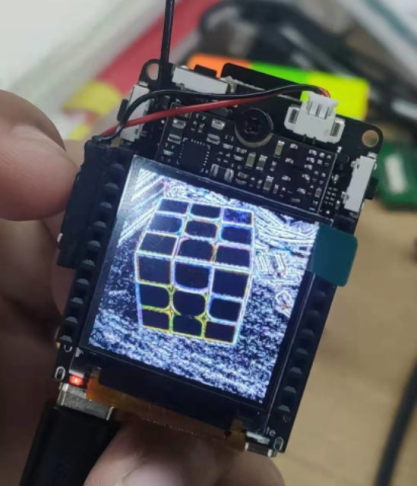v831 部署 Sobel 卷积边缘检测
| 时间 | 负责人 | 更新内容 | 备注 |
|---|---|---|---|
| 2021年8月3日 | neucrack | 首次编写并发布教程 | 发布于 neucrack 的博客 |
| 2021年10月23日 | Rui | 收集文章并整理到文档中 | --- |
| 2022年1月22日 | Rui & dianjixz | 使用 Jupyter 编写文档 | 工程文件下载,文档还需要二次整理 |
| 2022年1月18日 | Rui | 修改部分代码 | MaixPy3 更新到0.4.3,部分 API 发生变化 |
Windows 系统不支持!
边缘就是值变化剧烈的地方, 如果对值的变化求导, 则边缘部分就是导数局部最大。但是在图像处理时没有具体的函数让我们求导, 使用卷积运算则可以很好的近似替代。卷积运算是神经网络的最常用的基本运算,所以非常适合用来展示神经网络在 v831 上的部署过程。
边缘检测效果






卷积边缘检测原理
如下图, 假设左上为坐标原点, 横轴为 x, 纵轴为y, 如下图左上角9个像素点, P(x, y)表示坐标(x, y)的点, 要求P(1, 1)处在x轴的变化率, 则只需将P(2, 1) - P(0, 1) 得到值为0, P(1, 0)处为1-3 = -2, 这个差值即变化率, 类比成导数, 我们就能知道横轴在哪些地方变化率更大。

上面这种方法我们可以得到横轴的变化率, 这里使用卷积核
[-1, 0, 1],
[-2, 0, 2],
[-1, 0, 1]
对图像进行卷积运算, 如图中的计算方法, 像素点左右权值取2, 角上的也参与计算,但是权值为1,没有左右边的权值高. 这样我们就得到了横轴的变化率图, 即边缘检测图.
注意, 这里是对横轴计算了, 比较的点左右的值变化, 所以实际看到的图像会出现明显的纵轴边缘, 如下图左边

同理, 上图右边的图使用卷积核
[1, 2, 1],
[0, 0, 0],
[-1, -2, -1]
得到的纵轴的边缘图。
注意这里用右边减左边, 如果右边的值比左边的小会是负数, 如果我们希望只检测颜色值变大(变白)则可以直接使用, 如果两个变化方向都要检测, 则可以取绝对值. 比如下图左边是没有取绝对值, 右边取了绝对值

得到两个方向的图后, 对其进行合并, 对每个像素平方和开方即可

这张图左边是使用 GIMP 的 sobel 边缘检测(垂直+水平)的效果, 略微有点不同:

不同的原因是使用水平和垂直的图平方和开根后, 直接用 plt.imshow 显示, 和 GIMP 的处理方式不同
out = np.sqrt(np.square(out_v) + np.square(out_h))
plt.imshow(out)
简单地直接将值规范到[0, 255]就和 GIMP 的图相似了(但不完全一样)
out = np.sqrt(np.square(out_v) + np.square(out_h))
out = out * 255.0 / out.max()
plt.imshow(out.astype(np.uint8))

自定义卷积核来实现边缘检测
除了上面说了使用两次卷积计算, 也可以用只计算一次的卷积核, 比如:
[-1, -1, -1],
[ -1, 8, -1],
[ -1, -1, -1]
这是对于一个通道(灰度图)来说, 如果要扩充到三个通道(RGB), 卷积核参数就是如下形式
conv_rgb_core_sobel = [
[[-1,-1,-1],[-1,8,-1], [-1,-1,-1],
[0,0,0],[0,0,0], [0,0,0],
[0,0,0],[0,0,0], [0,0,0]
],
[[0,0,0],[0,0,0], [0,0,0],
[-1,-1,-1],[-1,8,-1], [-1,-1,-1],
[0,0,0],[0,0,0], [0,0,0]
],
[[0,0,0],[0,0,0], [0,0,0],
[0,0,0],[0,0,0], [0,0,0],
[-1,-1,-1],[-1,8,-1], [-1,-1,-1],
]]
经过卷积运算后, 前后图如下:

注意, 输入值范围如果为[0, 255], 输出值则范围会变化, 以图片形式查看时需要注意加以处理, 这里使用了plt.imshow(out)来显示, 这个函数会自动对图像做简单的处理, 才会看起来是黑色背景
导出成模型使用
可以将 Net 导出成 onnx 即可在其它平台使用, 就是一个简单的卷积层
部署到 V831 后的样子(使用了卷积核[-1,-1,-1],[-1,8,-1], [-1,-1,-1],):

V831 部署源码在 github, 模型在 MaixHub 上可以下载
边缘检测源码
这是在电脑上运行的代码,不是在开发板平台上运行的代码,需要安装 Pytorch 使用环境,请自行百度安装。工程文件下载
'''
simple sobel edge demo
visit: https://neucrack.com/p/377
@author neucrack
@license MIT
'''
# 引入模块
import torch
import torch.nn as nn
import numpy as np
from PIL import Image
import matplotlib.pyplot as plt
class Net(nn.Module):
def __init__(self):
super(Net, self).__init__()
self.conv1 = nn.Conv2d(3, 3, 3, padding=(0, 0), bias=False)
def forward(self, x):
x = self.conv1(x)
return x
net = Net()
# sobel全边缘检测算子
conv_rgb_core_sobel = [
[[-1,-1,-1],[-1,8,-1], [-1, -1, -1],
[0,0,0],[0,0,0], [0,0,0],
[0,0,0],[0,0,0], [0,0,0]
],
[[0,0,0],[0,0,0], [0,0,0],
[-1,-1,-1],[-1,8,-1], [-1, -1, -1],
[0,0,0],[0,0,0], [0,0,0]
],
[[0,0,0],[0,0,0], [0,0,0],
[0,0,0],[0,0,0], [0,0,0],
[-1,-1,-1],[-1,8,-1], [-1, -1, -1],
]]
# sobel垂直边缘检测算子
conv_rgb_core_sobel_vertical = [
[[-1,0,1],[-2,0,2], [-1, 0, 1],
[0,0,0],[0,0,0], [0,0,0],
[0,0,0],[0,0,0], [0,0,0]
],
[[0,0,0],[0,0,0], [0,0,0],
[-1,0,1],[-2,0,2], [-1, 0, 1],
[0,0,0],[0,0,0], [0,0,0]
],
[[0,0,0],[0,0,0], [0,0,0],
[0,0,0],[0,0,0], [0,0,0],
[-1,0,1],[-2,0,2], [-1, 0, 1],
]]
# sobel水平边缘检测算子
conv_rgb_core_sobel_horizontal = [
[[1,2,1],[0,0,0], [-1, -2, -1],
[0,0,0],[0,0,0], [0,0,0],
[0,0,0],[0,0,0], [0,0,0]
],
[[0,0,0],[0,0,0], [0,0,0],
[1,2,1],[0,0,0], [-1, -2, -1],
[0,0,0],[0,0,0], [0,0,0]
],
[[0,0,0],[0,0,0], [0,0,0],
[0,0,0],[0,0,0], [0,0,0],
[1,2,1],[0,0,0], [-1, -2, -1],
]]
def sobel(net, kernel):
sobel_kernel = np.array(kernel, dtype='float32')
sobel_kernel = sobel_kernel.reshape((3, 3, 3, 3))
net.conv1.weight.data = torch.from_numpy(sobel_kernel)
params = list(net.parameters())pil_img = Image.open("./images/class1_5.jpg")
display(pil_img)
input_img = np.array(pil_img)
print(input_img.shape)
input_tensor = (input_img.astype(np.float32) - 127.5) / 128 # to [-1, 1]
print(input_tensor.shape)
input_tensor = torch.Tensor(input_tensor).permute((2, 0, 1))
input_tensor = input_tensor.unsqueeze(0)
print("input shape:", input_tensor.shape)
(224, 224, 3)
input shape: torch.Size([1, 3, 224, 224])
input_tensor = (input_img.astype(np.float32) - 127.5) / 128 # to [-1, 1]
input_tensor = torch.Tensor(input_tensor).permute((2, 0, 1))
print(input_tensor.shape)
input_tensor = input_tensor.unsqueeze(0)
print("input shape:", input_tensor.shape)
torch.Size([3, 224, 224])
input shape: torch.Size([1, 3, 224, 224])
sobel_img_t = None
sobel_vertical_img_t = None
sobel_horizontal_img_t = None
#载入网络权重
sobel(net, conv_rgb_core_sobel_vertical)
#在推理模式下运行网络
with torch.no_grad():
out = net(input_tensor)
sobel_vertical_img_t = out.numpy()[0].transpose([1,2,0])
#载入网络权重
sobel(net, conv_rgb_core_sobel_horizontal)
#在推理模式下运行网络
with torch.no_grad():
out = net(input_tensor)
sobel_horizontal_img_t = out.numpy()[0].transpose([1,2,0])
#载入网络权重
sobel(net, conv_rgb_core_sobel)
#在推理模式下运行网络
with torch.no_grad():
out = net(input_tensor)
sobel_img_t = out.numpy()[0].transpose([1,2,0])
plt.figure()
plt.figure()
plt.subplot(1, 5, 1)
plt.imshow(input_img)
plt.subplot(1, 5, 2)
plt.imshow(sobel_img_t)
plt.subplot(1, 5, 3)
plt.imshow(sobel_vertical_img_t)
plt.subplot(1, 5, 4)
plt.imshow(sobel_horizontal_img_t)
plt.subplot(1, 5, 5)
out = np.sqrt(np.square(sobel_vertical_img_t) + np.square(sobel_horizontal_img_t))
plt.imshow(out)
plt.show()Clipping input data to the valid range for imshow with RGB data ([0..1] for floats or [0..255] for integers).
Clipping input data to the valid range for imshow with RGB data ([0..1] for floats or [0..255] for integers).
Clipping input data to the valid range for imshow with RGB data ([0..1] for floats or [0..255] for integers).
Clipping input data to the valid range for imshow with RGB data ([0..1] for floats or [0..255] for integers).
<Figure size 432x288 with 0 Axes>
with torch.no_grad():
torch.onnx.export(net, input_tensor, "./model.onnx", export_params=True, input_names = ["input0"], output_names=["output0"])
print("导出网络完成!")导出网络完成!
def onnx_to_ncnn(input_shape, onnx="out/model.onnx", ncnn_param="out/conv0.param", ncnn_bin = "out/conv0.bin"):
import os
# onnx2ncnn tool compiled from ncnn/tools/onnx, and in the buld dir
cmd = f"onnx2ncnn {onnx} {ncnn_param} {ncnn_bin}" #可以更换工具目录
os.system(cmd)
with open(ncnn_param) as f:
content = f.read().split("\n")
if len(input_shape) == 1:
content[2] += " 0={}".format(input_shape[0])
else:
content[2] += " 0={} 1={} 2={}".format(input_shape[2], input_shape[1], input_shape[0])
content = "\n".join(content)
with open(ncnn_param, "w") as f:
f.write(content)
onnx_to_ncnn(input_shape = (3, 224, 224), onnx = "./model.onnx", ncnn_param="./conv0.param", ncnn_bin = "./conv0.bin")
print("net success!")
net success!
使用 MaixHub 在线量化工具进行网络量化
在线转换需要上传一个压缩包文件
- 该功能只能支持上传一个无密码的 zip 压缩包
- 压缩包内需要包含一个 images 目录,一个 xxx.bin,一个 xxx.param
- 需要将矫正图片放入 images 目录内;矫正图片集可考虑直接采用训练中的验证数据集,并务必保证矫正时图像的预处理方式与训练和部署时一致。
注意:确保 images 目录内没有混入其他文件,否则会导致模型量化错误。
zip 压缩包目录结构
└─sobel.zip
.
├── images
│ ├── class1_0.jpg
│ ├── class1_1.jpg
│ ├── class1_2.jpg
│ ├── class1_3.jpg
│ ├── class1_4.jpg
│ └── class1_5.jpg
├── sobel.bin
└── sobel.param
1 directory, 8 files
制作好压缩包后,使用 MaixHub 的在线转换工具进行模型转换,查看使用说明。

登陆后,上传你的压缩包等待模型转换任务完成。
边缘检测模型部署
等待模型转换完成,下载转换好的模型文件。得到的 .param 和 .bin 文件就是部署在 v831 上的文件。
将模型文件上传到 v831 上。
# v831 运行边缘检测的代码
from maix import nn, camera, display, image
import numpy as np
import time
model = {
"param": "./sobel_int8.param",
"bin": "./sobel_int8.bin"
}
input_size = (224, 224, 3)
output_size = (222, 222, 3)
options = {
"model_type": "awnn",
"inputs": {
"input0": input_size
},
"outputs": {
"output0": output_size
},
"mean": [127.5, 127.5, 127.5],
"norm": [0.0078125, 0.0078125, 0.0078125],
}
print("-- load model:", model)
m = nn.load(model, opt=options)
print("-- load ok")
while True:
img = camera.capture().resize(224,224)
out = m.forward(img, quantize=True, layout="hwc")
out, = out.astype(np.float32).reshape(output_size)
out = (np.ndarray.__abs__(out) * 255 / out.max()).astype(np.uint8)
data = out.tobytes()
img2 = img.load(data,(222, 222), mode="RGB")
display.show(img2)边缘检测到此结束。



 Translate
Translate